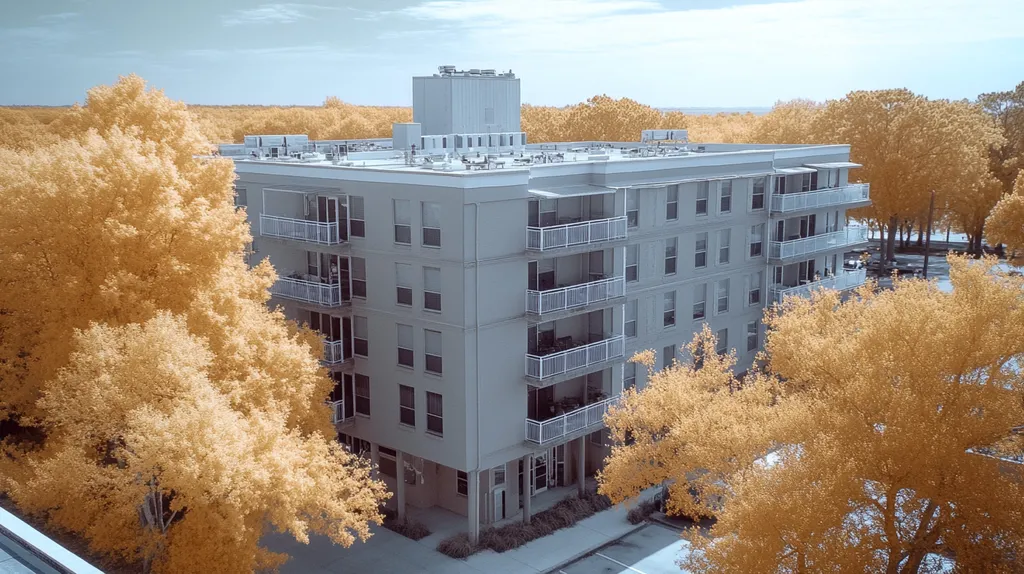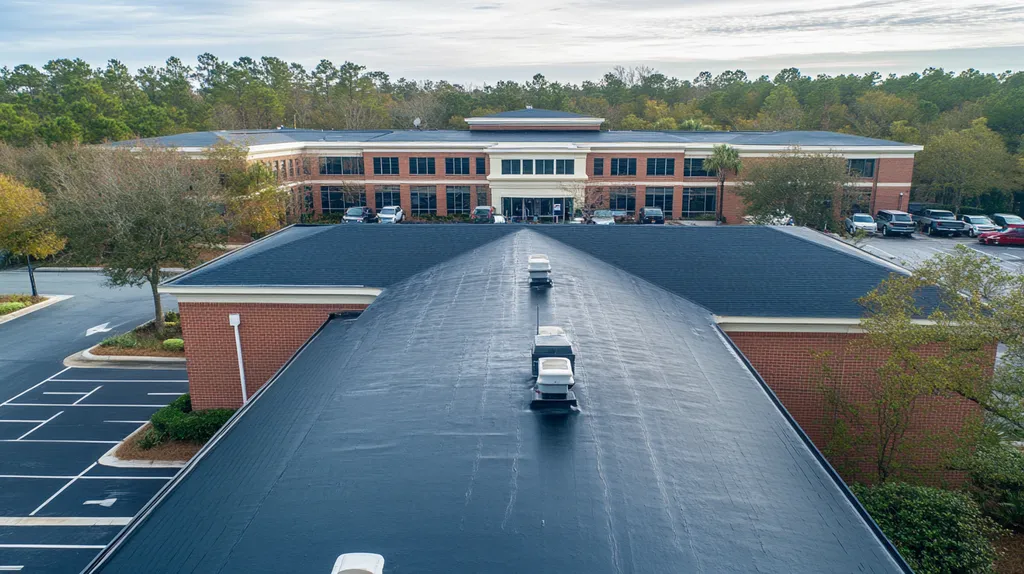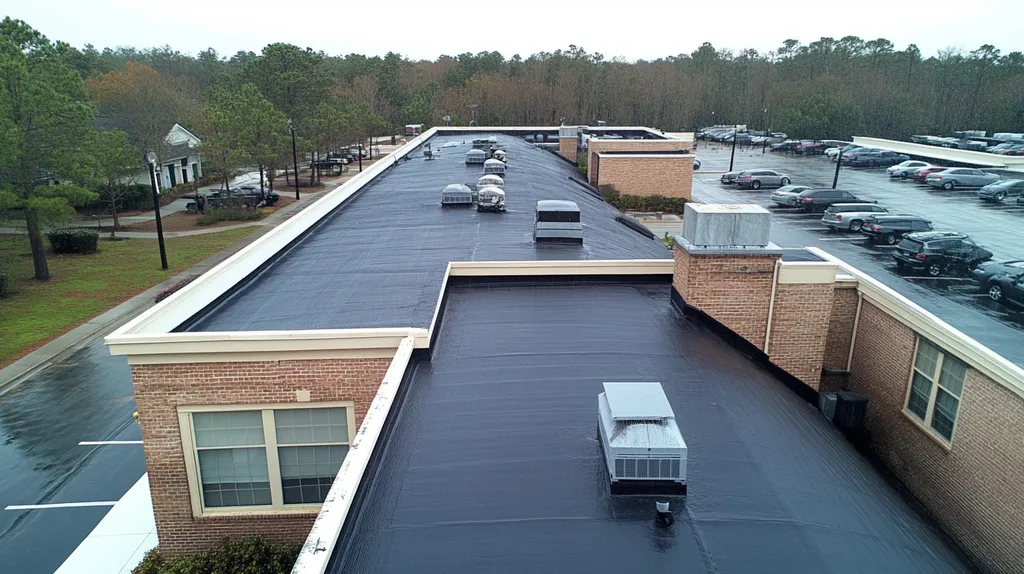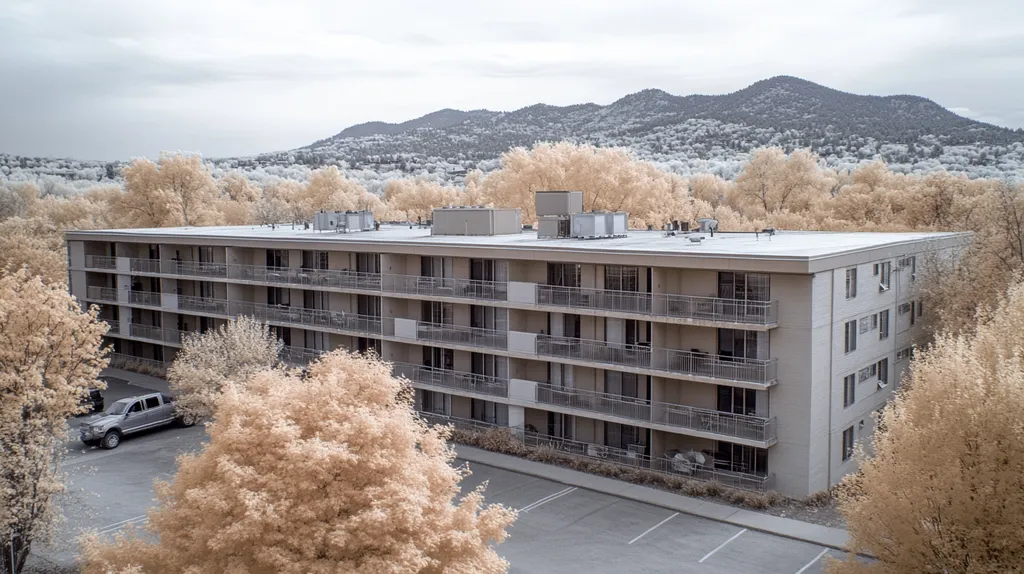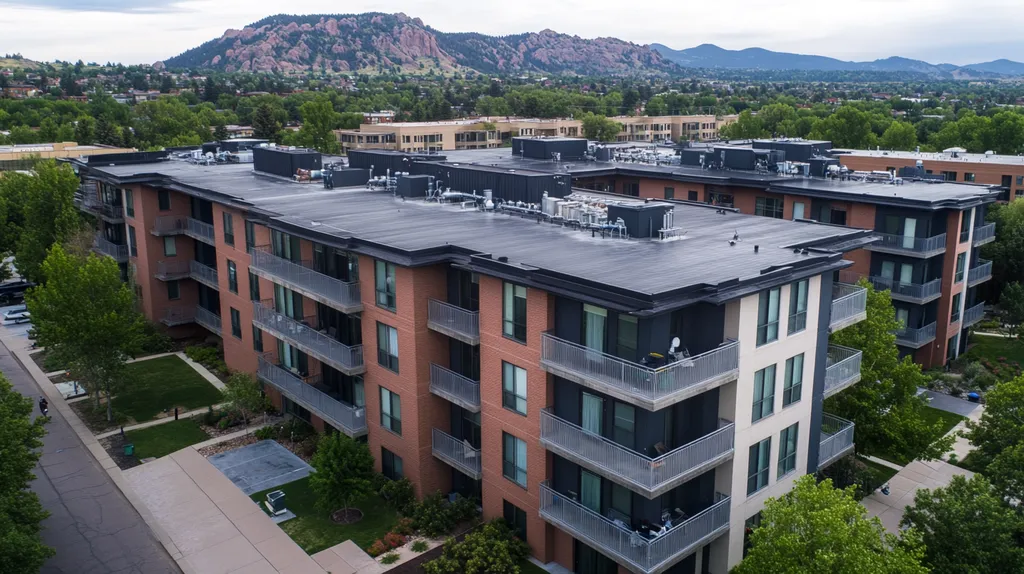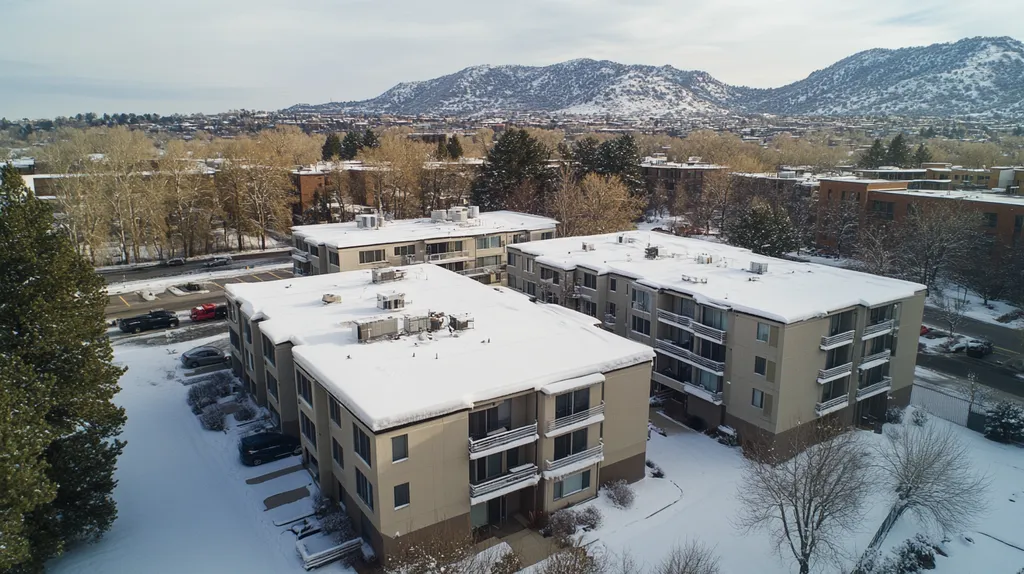Rising energy costs are forcing commercial building owners to confront an uncomfortable reality: up to 60% of a building’s heat gain occurs through inefficient roofing systems, driving cooling expenses skyward.
Modern reflective roofing technologies can slash these costs by 20-30%, yet studies show that 75% of commercial properties operate with suboptimal roof reflectivity ratings.
This comprehensive guide examines the critical relationship between roof reflectivity and energy consumption, providing property managers with actionable strategies to maximize efficiency and minimize operational costs.
SECTION 1: FUNDAMENTAL CONCEPTS
As energy costs continue to climb, commercial building owners face mounting pressure to optimize their roofing systems for maximum efficiency. The roof represents up to 60% of a building’s heat gain, making it a critical factor in energy management. Modern reflective roofing technologies can reduce cooling costs dramatically, yet many property owners overlook this vital opportunity for savings and sustainability.
Understanding Solar Reflectance and Thermal Emittance
Solar reflectance and thermal emittance work together as the key measurements of a roof’s energy performance. A cool roof generally has a reflectivity higher than 65 percent, while emissivity closer to 1.0 indicates better performance in re-radiating absorbed energy back to the sky.
These properties directly impact the temperature of the roof surface. Dark, non-reflective surfaces can reach temperatures exceeding 150°F on sunny days, while reflective surfaces often stay within 20°F of ambient air temperature.
High-performance roofing materials combine both properties effectively. The most efficient systems reflect incoming solar radiation while quickly releasing any absorbed heat, preventing it from transferring into the building.
In urban environments, these properties become even more critical. Buildings with low reflectivity and emissivity contribute to temperature increases of 6 to 8 degrees Fahrenheit in cities. (source: FacilitiesNet)
The Solar Reflectance Index (SRI) Explained
The Solar Reflectance Index provides a standardized way to compare different roofing materials’ energy performance. This single value combines both reflectance and emittance measurements into an easy-to-understand scale.
Higher SRI values indicate better thermal performance. Most high-performance commercial roofing systems achieve SRI ratings between 78 and 90, with some advanced materials reaching even higher.
Building codes increasingly reference SRI requirements. Many jurisdictions now mandate minimum SRI values for new commercial construction, particularly in urban areas targeting heat island reduction.
The index helps facility managers make direct comparisons between different roofing options. This standardization simplifies the process of selecting materials that will deliver the best energy performance for their specific climate and building type.
Impact of Reflectivity on Building Energy Consumption
Roof reflectivity directly affects a building’s cooling load and energy costs. Buildings with highly reflective roofs typically require 10-15% less energy for air conditioning during peak cooling periods.
The financial impact extends beyond direct energy savings. Reduced cooling loads mean HVAC systems operate more efficiently and require less maintenance, extending their operational life.
Temperature consistency improves throughout the building. Reflective roofs help maintain more stable indoor temperatures, reducing hot spots and improving occupant comfort across all floors.
These benefits compound over time. A reflective roof can generate substantial returns through reduced energy consumption, extended HVAC equipment life, and improved building value.
SECTION 2: SYSTEM COMPONENTS
Modern commercial roofing systems must balance multiple performance factors to deliver optimal energy efficiency. A building’s cooling costs can soar by 20-30% with poorly chosen roofing components. Understanding the interplay between materials, insulation, and coating technologies enables property owners to make decisions that significantly impact both operational costs and environmental footprint.
Roofing Materials and Their Reflectivity Ratings
There are three critical values that determine a roof’s energy performance: Total Solar Reflectivity (TSR), Thermal Emittance (TE), and the Solar Reflectance Index (SRI). TSR measures the roof’s ability to reflect solar energy on a scale of 0 to 1, while TE indicates how effectively the surface releases absorbed heat.
The SRI combines both TSR and TE measurements to provide a comprehensive performance indicator. Higher SRI values indicate better overall thermal performance, with most modern commercial materials targeting scores above 78.
These properties can change significantly over time due to weathering and accumulation of dirt. Energy Star compliance requires re-evaluation after three years to ensure continued performance.
Regular maintenance and cleaning help preserve initial reflectivity ratings throughout the roof’s service life. (source: IKO Roofing)
Insulation Types and Thermal Performance Standards
Commercial roof insulation systems typically combine multiple layers to achieve optimal thermal resistance. Modern materials like polyisocyanurate and extruded polystyrene offer superior R-values per inch compared to traditional options.
Cover boards protect insulation while providing additional thermal benefits. High-density options resist compression and maintain consistent R-values even under heavy foot traffic.
Proper installation technique dramatically affects insulation performance. Staggered joints, minimal gaps, and appropriate fastening patterns prevent thermal bridging and air infiltration.
Climate zone requirements determine minimum R-values for commercial buildings. Exceeding these baselines often delivers rapid returns through reduced heating and cooling costs.
Cool Roof Coatings and Membrane Technologies
Advanced coating systems can transform existing roofs into high-performance energy-saving assets. Elastomeric and acrylic formulations provide excellent UV resistance while maintaining flexibility across wide temperature ranges.
Single-ply membranes like TPO and PVC combine durability with superior reflective properties. These materials maintain their solar reflectance even after years of exposure, reducing long-term maintenance needs.
Multi-layer coating systems offer enhanced protection and energy performance. Base coats seal the substrate while reflective top coats maximize solar reflection and provide weather resistance.
Installation quality directly impacts coating performance. Proper surface preparation, consistent application thickness, and appropriate cure times ensure maximum benefit from cool roof technologies.
SECTION 3: IMPLEMENTATION METHODS
Modern commercial buildings face unprecedented pressure to maximize energy efficiency while controlling operational costs. High-performance roofing systems with optimized reflectivity can reduce cooling expenses by 20-30% annually. Yet implementing these solutions requires careful attention to material selection, installation quality, and regulatory compliance. Understanding these critical factors helps facility managers make informed decisions that deliver lasting value.
Selecting High-SRI Roof Systems for Commercial Buildings
The selection process for high-SRI roofing begins with understanding local climate conditions and building usage patterns. Single-ply membranes, coated metal systems, and specialized roof coatings each offer distinct advantages for different applications.
Material durability must be evaluated alongside initial reflectivity ratings. The most effective systems maintain their reflective properties even after years of weathering and exposure to environmental conditions.
A cool roof generally has a reflectivity higher than 65 percent, with high-performance systems maintaining a minimum rating of .50 after three years of service. This sustained performance is crucial for long-term energy savings and compliance with industry certifications. (source: FacilitiesNet)
System compatibility with existing building components must also be considered. The chosen solution should integrate seamlessly with current insulation, drainage systems, and mechanical equipment mounting points.
Installation Techniques to Maximize Reflectivity Benefits
Proper installation dramatically affects the performance of reflective roofing systems. Surface preparation, seam construction, and detail work all influence the roof’s ability to maintain consistent reflectivity across its entire area.
Crews must follow manufacturer-specified application procedures precisely. Even minor deviations from recommended installation methods can compromise the system’s reflective properties and energy performance.
Quality control during installation should focus on achieving uniform coverage and proper membrane attachment. Regular inspections throughout the installation process help ensure optimal results.
Post-installation verification testing confirms that the system meets specified reflectivity requirements. This includes surface temperature monitoring and reflectivity measurements across representative roof areas.
Integrating Reflective Roofing with Energy Codes and Standards
Current building codes increasingly emphasize roof system energy performance. Many jurisdictions now mandate minimum SRI values for new construction and major renovations, particularly in urban heat island zones.
Compliance documentation must track both initial and aged reflectivity ratings. Regular testing and maintenance programs help ensure continued conformance with applicable standards.
Building certification programs like LEED offer additional incentives for high-performance roofing systems. Points are awarded based on documented energy savings and sustained reflectivity performance.
Facility managers should develop comprehensive maintenance protocols that preserve reflective properties. This includes regular cleaning, coating renewal when needed, and prompt repair of any damage that could affect system performance.
SECTION 4: MAINTENANCE REQUIREMENTS
Even the highest-quality reflective roofing systems can lose 30-50% of their energy-saving capabilities within the first three years without proper maintenance. This degradation translates directly into higher cooling costs and reduced building efficiency. Understanding and implementing proper maintenance protocols isn’t just about preserving roof integrity – it’s about protecting a significant investment in energy efficiency and operational cost control.
Routine Inspection for Reflective Surface Integrity
Professional roof inspections should occur quarterly, with more frequent checks in areas experiencing extreme weather conditions or heavy industrial pollution. These evaluations must focus specifically on surface reflectivity degradation patterns.
A cool roof requires maintaining reflectivity above 65 percent to function effectively, with Energy Star certification demanding a minimum rating of .50 after three years of service. Regular monitoring helps identify when reflectivity approaches these critical thresholds. (source: FacilitiesNet)
Inspectors should document surface conditions through standardized photography and reflectivity measurements. This creates a historical record that helps predict maintenance needs and verify warranty compliance.
Special attention must focus on areas around HVAC units, vents, and other rooftop equipment where mechanical damage or chemical exposure could accelerate reflectivity loss.
Cleaning Protocols to Preserve Reflectivity Ratings
Establish a regular cleaning schedule based on local environmental conditions and rooftop exposure. Most commercial facilities require thorough cleaning at least twice annually, with additional spot cleaning as needed.
Use only manufacturer-approved cleaning solutions and methods. Harsh chemicals or abrasive cleaning techniques can permanently damage reflective surfaces, leading to premature degradation.
Document all cleaning activities, including methods used and surface conditions before and after. This information helps optimize cleaning frequency and verify the effectiveness of maintenance procedures.
Consider automated cleaning systems for large facilities or areas with frequent dirt accumulation. These systems can maintain consistent reflectivity levels while reducing labor costs.
Repair Strategies for Damaged Reflective Roof Areas
Develop clear protocols for addressing different types of surface damage. Minor scratches and wear patterns may require only spot treatment with approved reflective coatings.
More significant damage demands immediate professional evaluation. Delays in repairs can lead to accelerated degradation of surrounding areas and compromise overall roof performance.
Maintain an inventory of approved repair materials on site. Quick access to proper materials ensures timely repairs and consistent surface quality.
Track repair locations and frequencies to identify potential systemic issues. This data helps optimize maintenance schedules and inform future roofing decisions.
SECTION 5: PERFORMANCE METRICS
The financial stakes of roofing performance have never been higher for commercial property owners. A single percentage point drop in roof reflectivity can increase cooling costs by hundreds or thousands of dollars annually. Yet many facilities lack the rigorous measurement protocols needed to track and optimize their roof’s energy performance. Understanding and monitoring key metrics enables property owners to maximize energy savings while extending roof lifespans.
Measuring and Verifying Solar Reflectance and Emittance
Solar reflectance testing requires specialized equipment and standardized procedures to deliver accurate results. Most commercial facilities should conduct baseline measurements when new roofing is installed, followed by annual verification testing.
Emittance testing complements reflectance data by measuring how effectively the roof releases absorbed heat. Together, these metrics provide a complete picture of thermal performance.
ENERGY STAR qualified cool roofing products must maintain a minimum solar reflectance of 0.5 after three years of service. This benchmark helps property owners evaluate material performance over time. (source: U.S. Department of Energy)
Testing should focus on representative roof areas while accounting for variations in exposure and wear patterns. Special attention must be paid to areas around mechanical equipment and high-traffic zones.
Long-Term Performance and Weathering Effects on SRI
Environmental factors significantly impact a roof’s Solar Reflectance Index over time. UV exposure, pollution, and organic matter accumulation can reduce reflectivity by 10-15% annually without proper maintenance.
Temperature cycling causes microscopic surface changes that affect both reflectance and emittance. These effects accelerate in areas with extreme temperature variations or high pollution levels.
Regular cleaning and maintenance can preserve up to 90% of initial reflectivity ratings. Properties with aggressive maintenance programs typically maintain better performance throughout the roof’s service life.
Documentation of weathering patterns helps facility managers optimize maintenance schedules and predict when restoration or replacement may become necessary.
Using Energy Modeling to Quantify Cost Savings
Modern energy modeling software enables precise calculation of potential savings from reflective roofing investments. These tools account for local climate data, utility rates, and building-specific factors.
Simulation results help justify roofing investments by demonstrating concrete financial returns. The most efficient systems can deliver payback periods under three years in hot climates.
Models should incorporate both direct energy savings and indirect benefits like reduced HVAC wear. These comprehensive analyses often reveal additional value streams beyond simple utility cost reduction.
Regular model updates using actual performance data help refine predictions and validate investment decisions. This feedback loop improves future planning while documenting realized savings.
SECTION 6: OPTIMIZATION STRATEGIES
Commercial building owners face a critical challenge: energy costs continue to rise while roofing systems often operate at suboptimal efficiency. Studies show that implementing comprehensive roofing optimization strategies can reduce total building energy consumption by 25-35%. Yet most properties utilize only a fraction of available optimization techniques, leaving significant savings potential untapped. By strategically combining reflective surfaces, advanced insulation, and renewable energy systems, building owners can dramatically improve both performance and profitability.
Combining Reflective Roofs with Advanced Insulation Solutions
A reflective roof with high-performance insulation creates a powerful synergy that maximizes energy savings. The reflective surface minimizes heat absorption while proper insulation prevents transfer of any absorbed heat into the building envelope.
Modern insulation materials like polyisocyanurate and extruded polystyrene provide exceptional thermal resistance per inch. When paired with reflective surfaces, these materials can reduce cooling loads by up to 40% compared to traditional roofing systems.
A cool roof generally has a reflectivity higher than 65 percent, while proper insulation maintains consistent indoor temperatures regardless of exterior conditions. Together, these components work to dramatically reduce HVAC system strain and operating costs. (source: FacilitiesNet)
Strategic placement of insulation layers and careful attention to thermal bridging ensures maximum system performance. Proper installation techniques prevent gaps and compression that could compromise the insulation’s effectiveness.
Incorporating Renewable Energy with Cool Roofing Systems
Solar panel efficiency improves significantly when installed on cool roofs. Lower surface temperatures help photovoltaic systems operate at peak performance while extending their service life.
Modern mounting systems allow solar installations without compromising roof integrity or reflective properties. Careful planning ensures optimal panel orientation while maintaining proper drainage and access for maintenance.
The combination of solar generation and reduced cooling loads creates compelling financial returns. Many facilities see payback periods under five years when implementing both technologies simultaneously.
Building automation systems can maximize benefits by adjusting HVAC operations based on solar production and roof surface temperatures. This integration optimizes energy consumption throughout the day.
Leveraging Rebates and Incentives for Energy-Efficient Roofs
Federal, state, and local programs offer substantial financial incentives for energy-efficient roofing upgrades. These programs can reduce initial costs by 30% or more through tax credits, rebates, and grants.
Utility companies frequently provide additional incentives based on demonstrated energy savings. Some offer ongoing performance-based rewards that increase the long-term return on investment.
Professional energy audits help identify which incentive programs offer the greatest benefit for specific properties. This analysis ensures owners capture all available financial advantages.
Documentation requirements vary significantly between programs. Working with experienced contractors helps ensure compliance and maximum incentive capture.
The Bottom Line
Commercial building owners can no longer afford to ignore roofing efficiency – with energy costs rising 8-12% annually, every percentage point of lost reflectivity directly impacts the bottom line.
Studies consistently show that optimized reflective roofing systems reduce cooling costs by 20-30% while extending HVAC equipment life by up to five years.
Yet 75% of commercial properties still operate with suboptimal roof reflectivity ratings, leaving significant savings potential untapped.
By implementing the comprehensive strategies outlined in this guide – from material selection through maintenance protocols – facility managers can dramatically improve building performance while generating substantial returns on their roofing investments.
The technology exists – the only question is whether building owners will seize these opportunities before rising energy costs erode their profitability further.
FREQUENTLY ASKED QUESTIONS
Q. What are reflectivity ratings for commercial roofs?
A. Reflectivity ratings measure a roof’s ability to reflect solar energy. A roof is considered “cool” if it has a reflectivity higher than 65%. Higher ratings reduce heat absorption, leading to lower cooling costs and improved energy efficiency.
Q. How do reflectivity ratings impact industrial roof energy costs?
A. Higher reflectivity ratings on industrial roofs can significantly lower energy costs. By requiring 10-15% less energy for cooling, reflective roofs contribute to lower monthly bills. This improvement can also lead to extended lifespan for HVAC systems, lowering maintenance costs.
Q. What components affect the efficiency of a commercial roof?
A. Key components include roofing materials, insulation, and coatings. Each element influences the overall performance, as they work together to enhance energy efficiency. Choosing high-quality materials ensures optimal thermal resistance and reduced energy consumption.
Q. How can commercial roofs be optimally installed?
A. Optimal installation requires careful attention to surface preparation and manufacturer specifications. Following best practices ensures reflective properties are maintained. Regular inspections during the installation process help confirm that the roof meets established performance standards.
Q. What maintenance is necessary for a reflective commercial roof?
A. Regular maintenance includes routine inspections, cleaning, and prompt repairs. These practices help maintain reflectivity and prolong roof lifespan. Keeping a detailed maintenance log ensures compliance with warranties and helps predict future maintenance needs.
Q. How is the performance of a commercial roof measured?
A. Performance is measured through solar reflectance and emittance testing. Regular assessments, including annual checks after installation, help property owners track performance metrics. These measures ensure roofs maintain compliance and deliver promised energy savings over time.
Q. Can I combine renewable energy systems with my commercial roof?
A. Yes, integrating solar panels with a reflective roof enhances energy efficiency. Adding solar systems on cool roofs improves panel performance by reducing surface temperatures. This synergy creates significant energy savings and a speedy return on investment.

